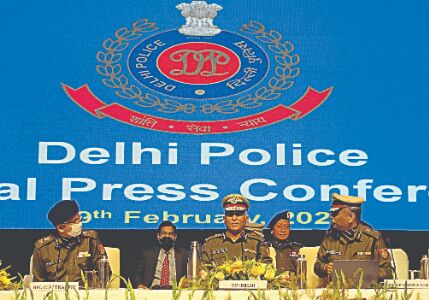'Tech used extensively to probe February riots'

New Delhi: While Delhi Police Commissioner SN Shrivastava on Friday announced that overall crime in the Capital had gone down by nearly 15 per cent in his first year as the top cop, data emerging from the annual crime review showed that the Commissioner and the Delhi Police have had a "challenging" time dealing with the slew of protests, demonstrations and agitations that took place throughout 2020.
In fact, according to their own data, the Delhi Police have had to deal with law and order situations arising out of 5,036 different kinds of rallies, agitations, demonstrations and public events throughout last year such as the wave of anti-CAA protests, the student protests by JMI and JNU students against police brutality and the CAA & NRC, the Shaheen Bagh protest, the MCD employees' strikes over unpaid salaries and many other political party protests and party events, the violence at JNU during their agitation against increased fees, the north-east Delhi riots, the farmers' protests and other events. This, of course, also includes handling the migrant workers' crisis in mid-2020 and the Tablighi Jamaat event just as the outbreak began here.
However, the Delhi Police had managed to handle all these law and order situations "patiently and deftly" to bring "peace and normalcy" back to the city, according to its own assessment of how it dealt with these situations.
The Delhi Police data showed that the city saw a total of 552 demonstrations, 34 processions, 121 meetings, 159 rallies and marches and 4,170 dharnas and strikes in all of 2020.
The police also added that they handle law and order situations even if it is a planned event like the India International Trade Fair at Pragati Maidan or a totally un-planned and snap demonstration by students protesting against a local university issue.
North-East Delhi riots
As for the riots in February 2020, in the aftermath of which Commissioner SN Shrivastava took over the police force, the top cop said that his force had been fair with the cases and registered complaints from members of all communities without partiality. He added that a total of 755 cases had been registered, over 340 chargesheet fled, over 400 cases solved and more than 1,800 arrested — without favour to any one or other community.
"Appropriate force was used effectively. 461 bullets were fired aerially, approximately 4,000 rounds of tear gas shells were fired. Countless baton charges were resorted to make the riotous crowds retreat," the police said.
According to police, they not only swiftly brought the situation under control but had ensured peace and normalcy in the area which is amply demonstrated by the fact that no communal incident was reported in the area of the North-East District in the remaining part of
the year.
In addition, the Commissioner noted that they had used technology extensively in the riots probes. Probe teams used video analytics and FRS to analyse CCTV footage to identify the accused, retrieved deleted data from electronic devices, used geo-location to ascertain the presence of the accused and drone mapping for crime scene reconstruction. The use of DNA fingerprinting, e-Vahan database, facial recognition, were common.
'Caught between two communities'
On repeated allegations against the police and its personnel about the cops "standing by", "being complicit" or "indulging in taking sides", the police said, "Earlier riots were by one community against the police. These riots saw face-off between large belligerent crowds of both communities at many places simultaneously with police in between the two crowds. However, the situation was never allowed to go out of hand and clashes between two groups were never allowed by the police in their presence. No lynching took place in the presence of police. No major casualties took place on main roads. Most casualties took place in interior areas where the police was not present and reached only after getting information to that effect."
"After a firm clampdown on the rioters, the process of restoring normalcy started. Aman Committee meetings, the return of residents to their homes, meetings of senior police officials with the residents, etc. set in motion the return to normalcy," the top cop said.
On handling of student protests
Among the major law and order challenges faced by the Delhi Police in 2020 were the various anti-government protests organised by students of Jawaharlal Nehru University and Jamia Millia Islamia that eventually spread to various parts of the city. The police have said that they handled the situation according to the law.
As for the violence on students inside the JMI campus during the anti-CAA protests of December 2019, the police said, "Patient and deft handling by Delhi Police ensured that there was no loss of life on both sides in spite of heavy violence resorted to by the
students."
On the violence inside the JNU campus by masked goons who entered the campus with sticks, some with fiberglass batons used by police, the Delhi Police have said, "Peace was maintained and an adequate police force was deployed in plainclothes inside JNU premises as requested by the JNU administration." Police had entered the campus, after JNUSU president Aishe Ghosh, few other students and two professors were critically injured by the
goons.
Commenting on the specific challenges of handling student protests, the police said, "Considering the fact that such young educated group of protestors attract lot of media attention and are more organised to plan and conduct surprise protests, professional and patient handling by the police helped in managing the wave of such protests smoothly and
professionally."



